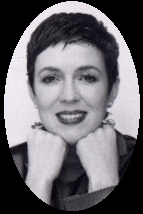
 born: 1958 |
Bibliography:
|
"Palazzo Dario" (List Verlag, Germany, 1999, read: July 99, only available in German)
In the cover text it also says that this is a roman à clef about Venice and it's inhabitants, which is
"a novel in which real people and events are described in a way that they can be recognized"
(German Brockhaus). Palazzo Dario is real and it's described in the travel guide 'Dumont Visuelle' as:
"The now rather askew palace was built in 1487 as one of the first renaissance buildings in Venice. His
facade is asymmetrical, ..., and exessively adorned with marble and porphyr." (p 212).

"Wanda Viarelli has thousands of pictures of love, decay and gondolas in her head as she moves
from her beloved Naples to conquer Venice. She was selected among hundreds of contestants to
become curator at the Museo Orientale and is able to live with her uncle in Palazzo Dario right at the
Canale Grande. But not only the uncle needs getting used to. Also the other inhabitants of the
palazzo, the chain-smoking Maria and Michel, require a lot from Wanda.
But what really makes her nervous are the numerous stories about the curse which seems to lay on
Palazzo Dario. And in fact quite a few strange things are happening here at the Canale Grande
against which neither conjurations, sent from her superstitious father in Naples to the far away
Venice, nor her love to Primo, the beautiful gondoliere, can do something about ..."
(Translation from the German cover text)
It's no wonder that this 'asymmetrical' palace attracts strange inhabitants and visitors. For example
Wanda's uncle Radomir Radziwill, a fanatical carnival fan with a noble background and a liking of
anectotes which nobody wants to hear. Or Maria, the maid, who rather does crossword puzzles
than clean the palace but cooks a marvelous fish soup.
The story alternates between the experiences of Wanda and the tragic stories of earlier inhabitants
of the palace who, in one way or another, fell victim to the curse. And it's only a matter of time before
the curse raises its ugly head again. Even a magician and fumigating candles can do nothing to
help.
Everyone who's been to Venice before will recognize a lot of things ... the peculiar ways of the
Venetians and the specialties of the city are described at lengh and in a very funny way. The
story is also a little bit dark and morbid. And the titles of the single chapters just make curious,
e.g. "Wanda's first working day at the Museo Orientale. She gets to know a capman and learns
what 50 Bavarians mean in Venice". The ending comes a little bit unexpected but once it's there
one has learned enough about Venice to get back there for sure and to look at it live.
[Dorothée Büttgen, July 99]
More great reviews at Bookworm's Lair:



